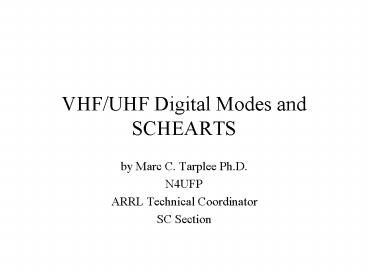VHF/UHF Digital Modes and SCHEARTS - PowerPoint PPT Presentation
1 / 16
Title:
VHF/UHF Digital Modes and SCHEARTS
Description:
This would allow statewide voice and data traffic ... low-speed data (1200 bit/sec) GPS/APRS info can be transmitted simultaneously with DV ... – PowerPoint PPT presentation
Number of Views:124
Avg rating:3.0/5.0
Title: VHF/UHF Digital Modes and SCHEARTS
1
VHF/UHF Digital Modes and SCHEARTS
- by Marc C. Tarplee Ph.D.
- N4UFP
- ARRL Technical Coordinator
- SC Section
2
History/Background
3
VHF Packet
- Developed in Canada in 1978.
- Uses AX.25 protocol at 1200 or 9600 bit/sec
- Popularity of packet increased throughout the
1980s, then declined in the late 1990s with the
advent of the WWW. - AX.25 supports digital repeating (digipeating)
- Packet modulation scheme (NBFM) is compatible
with existing repeaters.
4
APCO Project 25
- Commercial standard for digital voice/data
communications for public service agencies - Developed in 1996 by APCO (Association of Public
Safety Communications Officials) and equipment
manufacturers - Supports digital voice/data transmission at 9600
bit/sec - Supports encryption and talk groups
- Modulation schemes for P-25 (CQPSK, C4FM) are not
compatible with existing repeaters
5
D-Star
- Developed in Japan in 2001
- Result of partnership between Japanese
government, JARL, and equipment manufacturers - Supports digital voice transmission at 4800
bit/sec - Supports data transfer at 128 kbit/sec or
10 Mbit/sec - Modulation schemes for D-Star (GMSK, QPSK, 4FSK)
are not compatible with existing repeaters - Supports digital repeating (digipeating)
6
Comparison
7
Technical Standards
APCO 25 D-Star AX.25 Packet
Modulation Type Digital Voice/Data Digital Voice/Data Data
Modulation Scheme CQPSK C4FM QPSK 4FSK GMSK NBFM
Bit Rate 9600 bit/sec 4800 bit/sec 128 kbit/sec 10 MBit/sec 1200 bit/sec 9600 bit/sec
Bandwidth 6.25 KHz 12.5 KHz 6.25 KHz 150 KHz 10.5 MHz 15 KHz
Vocoder IMBE vocoder, 4400 bits/s 2800 bits/s FEC AMBE vocoder, 2400 bit/s 3600 bit/s FEC None
Digipeating No Yes Yes
Call sign Addressing No Yes Yes
Encryption Yes No No
Legacy System Compatible No No Yes
Open Standard No Yes Yes
8
Analysis
- Packets severe limitations (low speed, no DV
capability) offset its compatibility advantage. - P25 implementation in SC will be limited to
frequencies above 700 MHz, so equipment that
could be modified for use on amateur bands will
not be available. - P25 does not support call sign addressing and
encryption capability violates Part 97 Rules, and
it is a closed standard - D-Star offers DV, low-speed and high-speed data
transfer, call sign addressing and digipeating.
It is also an open standard - D-Stars incompatibility with legacy equipment
limits its deployment to new systems.
9
Recommendation
- Implement D-Star within SCHEARTS.
- This implementation would not affect existing FM
repeater networks. - D-Star would add additional functionality, rather
than replace existing systems - High-speed D-Star systems operating on 23cm would
relieve crowding on 2m and 70cm bands - Low-speed D-Star systems can be interleaved
between existing NBFM on 2m and 70cm to improve
spectrum usage
10
Interleaving
- D-Star signals are placed in guard bands between
NBFM signals - Modulation schemes are incompatible, so NBFM
receiver rejects D-Star signals and vice versa.
11
Applications of D-Star
12
D-Star across the US
- Alabama Linked Repeater Network is implementing
D-Star on 23cm to provide statewide data transfer - Emergency Minnesota 145.67 MHz Wide Area Amateur
Packet Radio Network is adding 23cm D-Star
capability to to support 128kbps digital data
and web software based public service
applications on Amateur Radio frequencies.
13
D-Star in Williamson County, TN
- 23cm D-Star links used to provide RF data link
between ARES computers at various sites - For more details, see Oct 2005 QST p 81
14
Application to SCHEARTS
- Link existing local repeater networks through
wide area D-Star repeaters. - This would allow statewide voice and data traffic
- This would provide an RF backup for web-based
applications - Use low-speed D-Star to augment existing local
repeater networks - D-Star allows simultaneous transmission of DV and
low-speed data (1200 bit/sec) GPS/APRS info can
be transmitted simultaneously with DV - D-Stars narrow bandwidth promotes better
spectrum utilization - D-Stars DV addressing capabilities facilitate
directed communications
15
Closing Comments
16
Food For Thought
- Implementation of new digital technologies does
not have to make legacy technologies obsolete - Digital technologies can coexist with existing
technologies, delivering services such as file
sharing, access to the WWW, and instant messaging
that cannot be otherwise provided - Implementation of P25 in the public service arena
means that the agencies we serve will become
comfortable with and reliant on digital
communications technologies and will expect
amateurs to provide similar services.































